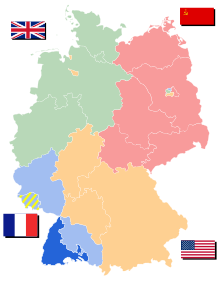
The Free Democratic Party is a liberal political party in Germany.
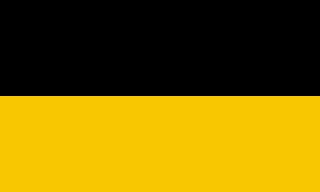
Baden-Württemberg, commonly shortened to BW or BaWü, is a German state in Southwest Germany, east of the Rhine, which forms the southern part of Germany's western border with France. With more than 11.07 million inhabitants as of 2019 across a total area of nearly 35,752 km2 (13,804 sq mi), it is the third-largest German state by both area and population. As a federated state, Baden-Württemberg is a partly-sovereign parliamentary republic. The largest city in Baden-Württemberg is the state capital of Stuttgart, followed by Mannheim and Karlsruhe. Other major cities are Freiburg im Breisgau, Heidelberg, Heilbronn, Pforzheim, Reutlingen, Tübingen, and Ulm.

The Federal Republic of Germany, as a federal state, consists of sixteen states. Berlin, Hamburg and Bremen are called Stadtstaaten ("city-states"), while the other thirteen states are called Flächenländer and include Bavaria, Saxony, and Thuringia, which describe themselves as Freistaaten.

The Bizone or Bizonia was the combination of the American and the British occupation zones on 1 January 1947 during the occupation of Germany after World War II. With the addition of the French occupation zone on 1 August 1948 the entity became the Trizone. Later, on 23 May 1949, the Trizone became the Federal Republic of Germany, commonly known as West Germany.
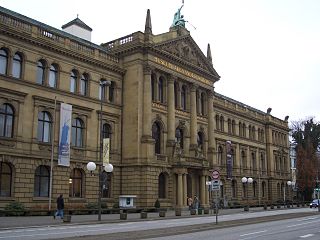
The Parlamentarischer Rat was the West German constituent assembly in Bonn that drafted and adopted the constitution of West Germany, the Basic Law for the Federal Republic of Germany, promulgated on 23 May 1949.

Württemberg-Baden was a state of the Federal Republic of Germany. It was created in 1945 by the United States occupation forces, after the previous states of Baden and Württemberg had been split up between the US and French occupation zones. Its capital was Stuttgart. In 1952, Württemberg-Baden merged with Württemberg-Hohenzollern and Baden into the present state of Baden-Württemberg.

Württemberg-Hohenzollern was a West German state created in 1945 as part of the French post-World War II occupation zone. Its capital was Tübingen. In 1952, it was merged into the newly founded state of Baden-Württemberg.

The entirety of Germany was occupied and administered by the Allies of World War II, from the Berlin Declaration on 5 June 1945 to the establishment of West Germany on 23 May 1949. Unlike occupied Japan, Nazi Germany was stripped of its sovereignty and former state: after Germany formally surrendered on 8 May 1945, the four countries representing the Allies asserted joint authority and sovereignty through the Allied Control Council (ACC).

Carlo Schmid was a German academic and politician of the Social Democratic Party of Germany (SPD).

The Republic of Baden was a German state that existed during the time of the Weimar Republic, formed after the abolition of the Grand Duchy of Baden in 1918. It is now part of the modern German state of Baden-Württemberg.

The Free People's State of Württemberg was a state which existed in the Weimar Republic and from 1933 in Nazi Germany.

Franz Heinrich Köhler was a German politician who served as Minister of Finance of the Weimar Republic in 1927/8. He also was the head of state (Staatspräsident) of the Republic of Baden in 1923/4 and 1926/7.
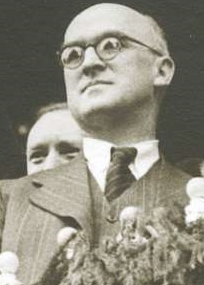
Gebhard Müller was a German lawyer and politician (CDU). He was President of Württemberg-Hohenzollern (1948–1952), Minister President of Baden-Württemberg (1953–1958) and President of the Federal Constitutional Court of Germany (1959-1971). He was born in Füramoos and died in Stuttgart.

Baden is a historical territory in South Germany. In earlier times it was considered to be on both sides of the Upper Rhine, but since the Napoleonic Wars, it has been considered only East of the Rhine.
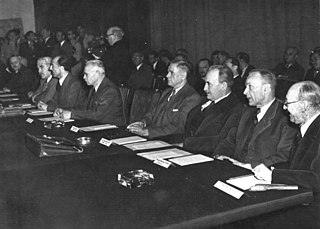
The Frankfurt Documents were an important formal step towards the founding of the Federal Republic of Germany at the I.G.-Farben-Building in Frankfurt am Main.
The Minister-president is the head of state and government in thirteen of Germany's sixteen states.
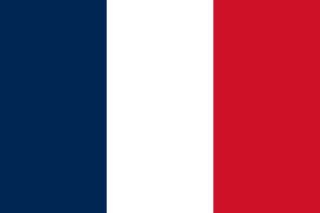
The French occupation zone in Germany was one of the Allied-occupied areas in Germany after World War II.

A referendum was held on 9 December 1951 in the states of South Baden, Württemberg-Baden, and Württemberg-Hohenzollern. Voters were asked whether they favoured a merger of the three states into a single state or the re-establishment of the old states of Baden and Württemberg. 69.7% of voters favoured unification with a turnout of 59.2%.

The American occupation zone in Germany, also known as the US-Zone, and the Southwest zone, was one of the four occupation zones established by the Allies of World War II in Germany west of the Oder–Neisse line in July 1945, around two months after the German surrender and the end of World War II in Europe. It was controlled by the Office of Military Government, United States (OMGUS) and ceased to exist after the establishment of the Federal Republic of Germany on 21 September 1949, but the United States maintains military presence across Germany.

The Landtag of Württemberg-Hohenzollern was the first freely elected Parliament of the state of Württemberg-Hohenzollern following the states formation after the second World War inside of the French zone of occupation. The Landtag was the body succeeding the Advisory State Assembly of Württemberg-Hohenzollern, the convention composed of municipal delegates was tasked with drafting a constitution for the state. The first election to the Landtag was held simultaneously with the referendum over the adpotion of the constitution drafted by the Advisory State Assembly on 18 May 1947.
